

Paleozoic. Cambrian. Key events in the Cambrian Stratigraphic scale of the ICS subdivisions and Precambrian/Cambrian boundary.

The Cambrian (/ˈkæmbriən/) is the first geological period of the Paleozoic Era, lasting from 541.0 ± 1.0 to 485.4 ± 1.9 million years ago (mya) and is succeeded by the Ordovician.[5] Its subdivisions, and indeed its base, are somewhat in flux. The period was established by Adam Sedgwick, who named it after Cambria, the Latin name for Wales, where Britain's Cambrian rocks are best exposed.[6] The Cambrian is unique in its unusually high proportion of lagerstätten.
These are sites of exceptional preservation, where 'soft' parts of organisms are preserved as well as their more resistant shells. Invertebrate. Invertebrates form a massively paraphyletic group.
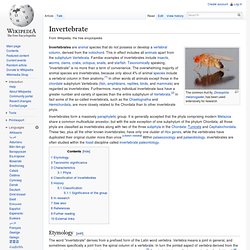
It is generally accepted that the phyla comprising modern Metazoa share a common multicellular ancestor, but with the sole exception of one subphylum of the phylum Chordata, all those phyla are classified as invertebrates along with two of the three subphyla in the Chordata: Tunicata and Cephalochordata. These two, plus all the other known invertebrates, have only one cluster of Hox genes, while the vertebrates have duplicated their original cluster more than once.
[citation needed] Within palaeozoology and palaeobiology, invertebrates are often studied within the fossil discipline called invertebrate paleontology. Trilobite. Trilobites had many life styles; some moved over the sea-bed as predators, scavengers or filter feeders and some swam, feeding on plankton.
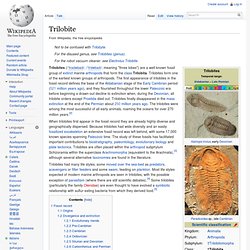
Most life styles expected of modern marine arthropods are seen in trilobites, with the possible exception of parasitism (where there are still scientific debates).[4] Some trilobites (particularly the family Olenidae) are even thought to have evolved a symbiotic relationship with sulfur-eating bacteria from which they derived food.[5] Fossil record[edit] All Olenellina lack facial sutures (see below), and this is thought to represent the original state. Ordovician. Life continued to flourish during the Ordovician as it did in the Cambrian, although the end of the period was marked by a significant mass extinction.
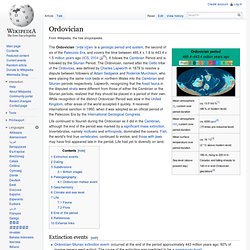
Invertebrates, namely mollusks and arthropods, dominated the oceans. Fish, the world's first true vertebrates, continued to evolve, and those with jaws may have first appeared late in the period. Life had yet to diversify on land. Silurian. A significant evolutionary milestone during the Silurian was the diversification of jawed and bony fish.

Life also began to appear on land in the form of small, moss-like, vascular plants which grew beside lakes, streams, and coastlines, and also in the form of small terrestrial arthropods. However, terrestrial life would not greatly diversify and affect the landscape until the Devonian. History of study[edit] The Silurian system was first identified by British geologist Sir Roderick Impey Murchison, who was examining fossil-bearing sedimentary rock strata in south Wales in the early 1830s. Plant. Green plants obtain most of their energy from sunlight via photosynthesis by primary chloroplasts that are derived from endosymbiosis with cyanobacteria.

Their chloroplasts contain chlorophylls a and b, which gives them their green color. Some plants are parasitic or mycotrophic and have lost the ability to produce normal amounts of chlorophyll or to photosynthesize. Plants are characterized by sexual reproduction and alternation of generations, although asexual reproduction is also common.
There are about 320 thousand species of plants, of which the great majority, some 260–290 thousand, are seed plants (see the table below).[5] Green plants provide a substantial proportion of the world's molecular oxygen[6] and are the basis of most of Earth's ecosystems, especially on land. Plants that produce grain, fruit and vegetables form humankind's basic foods, and have been domesticated for millennia. Definition Current definitions of Plantae Algae Fungi Diversity Evolution. Fish. Because the term "fish" is defined negatively, and excludes the tetrapods (i.e., the amphibians, reptiles, birds and mammals) which descend from within the same ancestry, it is paraphyletic, and is not considered a proper grouping in systematic biology.
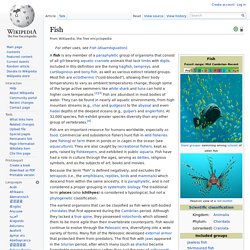
The traditional term pisces (also ichthyes) is considered a typological, but not a phylogenetic classification. The earliest organisms that can be classified as fish were soft-bodied chordates that first appeared during the Cambrian period. Although they lacked a true spine, they possessed notochords which allowed them to be more agile than their invertebrate counterparts. Fish would continue to evolve through the Paleozoic era, diversifying into a wide variety of forms. Many fish of the Paleozoic developed external armor that protected them from predators.
Evolution Outdated evolutionary view of continual gradation Fish do not represent a monophyletic group, and therefore the "evolution of fish" is not studied as a single event.[5] Anatomy. Devonian. The Devonian is a geologic period and system of the Paleozoic Era spanning from the end of the Silurian Period, about 419.2 ± 3.2 Mya (million years ago), to the beginning of the Carboniferous Period, about 358.9 ± 0.4.[5] It is named after Devon, England, where rocks from this period were first studied.
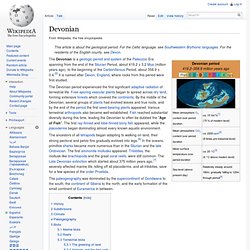
The Devonian period experienced the first significant adaptive radiation of terrestrial life. Free-sporing vascular plants began to spread across dry land, forming extensive forests which covered the continents. By the middle of the Devonian, several groups of plants had evolved leaves and true roots, and by the end of the period the first seed-bearing plants appeared. Various terrestrial arthropods also became well-established.
Amphibian. Evolutionary history[edit] Top: Restoration of Eusthenopteron, a fully aquatic lobe-finned fish Bottom: Restoration of Tiktaalik, an advanced tetrapodomorph fish The first major groups of amphibians developed in the Devonian period, around 370 million years ago, from lobe-finned fish similar to the modern coelacanth and lungfish,[2] which had evolved multi-jointed leg-like fins with digits that enabled them to crawl along the sea bottom.
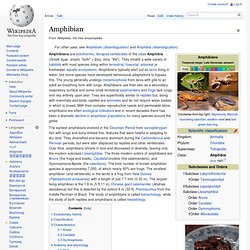
Some fish had developed primitive lungs to help them breathe air when the stagnant pools of the Devonian swamps were low in oxygen. They could also use their strong fins to hoist themselves out of the water and onto dry land if circumstances so required. Ichthyostega was one of the first primitive amphibians, with nostrils and more efficient lungs. Insect. Carboniferous. Subdivisions[edit] Late Pennsylvanian: Gzhelian (most recent) Noginskian / Virgilian (part) Late Pennsylvanian: Kasimovian KlazminskianDorogomilovksian / Virgilian (part)Chamovnicheskian / Cantabrian / MissourianKrevyakinskian / Cantabrian / Missourian Middle Pennsylvanian: Moscovian Myachkovskian / Bolsovian / DesmoinesianPodolskian / DesmoinesianKashirskian / AtokanVereiskian / Bolsovian / Atokan Early Pennsylvanian: Bashkirian / Morrowan Melekesskian / DuckmantianCheremshanskian / LangsettianYeadonianMarsdenianKinderscoutian Late Mississippian: Serpukhovian AlportianChokierian / Chesterian / ElvirianArnsbergian / ElvirianPendleian Middle Mississippian: Visean.

Pterygota. The pterygotan group comprises almost all insects. The hexapod orders not included are the Archaeognatha (jumping bristletails) and the Thysanura (silverfishes and firebrats), two primitively wingless insect orders. Also not included are the three orders no longer considered to be insects: Protura, Collembola, and Diplura. Systematics[edit] Traditionally, this group was divided into the infraclasses Paleoptera and Neoptera. The former are nowadays strongly suspected of being paraphyletic, and better treatments (such as dividing or dissolving the group) are presently being discussed. The following scheme uses finer divisions than the one above, which is not well-suited to correctly accommodating the fossil groups. Infraclass Paleoptera[edit] (probably paraphyletic) Infraclass Neoptera[edit] Superorder Exopterygota Superorder Endopterygota Neoptera orders incertae sedis External links[edit] Media related to Pterygota at Wikimedia Commons.
Gymnosperm. Classification[edit] In early classification schemes, the gymnosperms (Gymnospermae) were regarded as a "natural" group. There is conflicting evidence on the question of whether the living gymnosperms form a clade.[1][2] The fossil record of gymnosperms includes many distinctive taxa that do not belong to the four modern groups, including seed-bearing trees that have a somewhat fern-like vegetative morphology (the so-called "seed ferns" or pteridosperms.)[3] When fossil gymnosperms such as Bennettitales, Caytonia and the glossopterids are considered, it is clear that angiosperms are nested within a larger gymnosperm clade, although which group of gymnosperms is their closest relative remains unclear.
For the most recent classification on extant gymnosperms see Christenhusz et al. (2011).[4] Subclass Cycadidae. Reptile. The earliest known reptiles originated around 315 million years ago during the Carboniferous period, having evolved from advanced reptile-like amphibians that became increasingly adapted to life on dry land. Some early examples include the lizard-like Hylonomus, Casineria and possibly Westlothiana, although the latter may be an advanced land-dwelling amphibian. In addition to the living reptiles, there are many diverse groups that are now extinct, in some cases due to mass extinction events. In particular, the K–Pg extinction wiped out the pterosaurs, plesiosaurs, ornithischians, and sauropods, as well as many species of theropods (e.g. tyrannosaurs and dromaeosaurids), crocodyliforms, and squamates (e.g. mosasaurids). Permian. The Permian witnessed the diversification of the early amniotes into the ancestral groups of the mammals, turtles, lepidosaurs and archosaurs.
The world at the time was dominated by a single supercontinent known as Pangaea, surrounded by a global ocean called Panthalassa. The extensive rainforests of the Carboniferous had disappeared, leaving behind vast regions of arid desert within the continental interior. Reptiles, who could better cope with these drier conditions, rose to dominance in lieu of their amphibian ancestors.
The Permian Period (along with the Paleozoic Era) ended with the largest mass extinction in Earth's history, in which nearly 90% of marine species and 70% of terrestrial species died out.[6] It would take well into the Triassic for life to recover from this catastrophe. Discovery[edit] Archosaur. Archosaurs are a group of diapsid amniotes whose living representatives consist of birds and crocodilians.